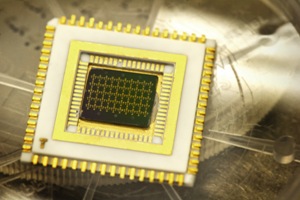Sep 12 2014
Researchers from the University of Texas (UT), Arlington have developed a new technique of cooling electrons to temperatures as low as -228°C at ambient conditions, without external cooling.
 A chip, which contains nanoscale structures that enable electron cooling at room temperature, is pictured.
A chip, which contains nanoscale structures that enable electron cooling at room temperature, is pictured.
In this method, the electrons are transmitted via a quantum well to prevent them heating up.
He stated that electrons naturally undergo thermal excitation at ambient temperature. By effectively suppressing electron excitation, the electron temperature can be reduced without external means.
The researchers developed a nanoscale structure comprising a quantum dot, two tunneling barriers, a quantum well, a source electrode and a drain electrode for preventing excitation of electrons. The use of cold electrons paves the way for an innovative transistor model with low energy consumption.
We are the first to effectively cool electrons at room temperature. Researchers have done electron cooling before, but only when the entire device is immersed into an extremely cold cooling bath.
Seong Jin Koh, an associate professor at UT Arlington in the Materials Science & Engineering Department
UT Arlington College of Engineering Dean, Khosrow Behbehani stated that the research addresses the global challenge of using energy-efficient technologies that benefit the environment.
National Science Foundation’s Directorate for Engineering program director, Usha Varshney said that the energy consumption of electronic devices could be reduced by over 10 times with the help of the transistors incorporated with this novel technique.
Potential applications of the research findings include electronics used in military such as unmanned aerial vehicles, high-capacity computing operations and remote sensors. Future work may include determining the elements that allows further cooling of electrons. However, preventing the electrons from acquiring energy while moving across the device, is a great challenge.
The research is published in the journal, Nature Communications.
References